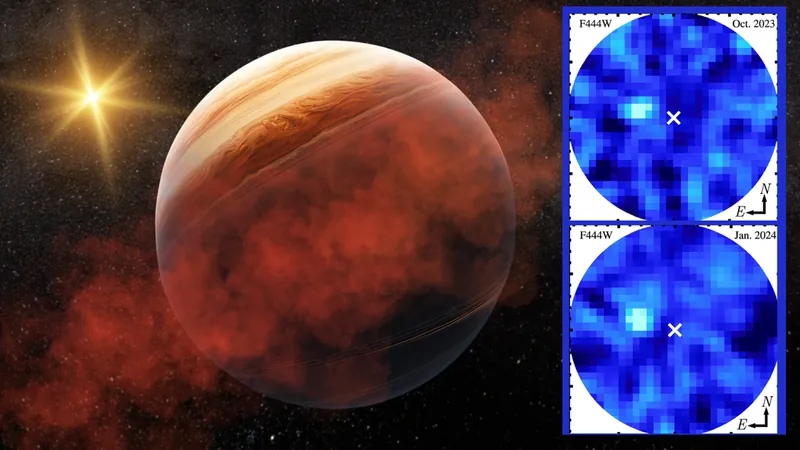
James Webb Space Telescope Triumphs in the Quest to Capture Images of Young Exoplanet AF Leporis b
2024-10-14
Author: Wai
Introduction
In a groundbreaking achievement, the James Webb Space Telescope (JWST) has successfully captured direct images of the lowest-mass exoplanet discovered beyond our solar system to date. This remarkable feat also marks the first time the JWST has directly observed a planet that is in close proximity to its star.
AF Leporis b: A Cosmic Race Against Time
Dubbed AF Leporis b (or AF Lep b), this exoplanet was the star of a “race against time.” Positioned near its parent star, it was on the verge of being lost behind its blinding light for potentially up to a decade. Astronomers acted swiftly to seize the opportunity to analyze this celestial body before it became obscured.
Lowest-Mass Exoplanet and Its Characteristics
In 2023, AF Lep b set a record as the lowest-mass exoplanet ever identified through direct observation. It is also noteworthy for being the lightest planet to have its mass measured by astrometry—a sophisticated technique that tracks the motion of its host star over several years, detecting tiny gravitational influences caused by orbiting planets.
Age and Size of AF Leporis b
At a tender age of approximately 23 million years, AF Lep b might sound ancient in cosmic terms, yet it is relatively young compared to Earth, which formed around 4.6 billion years ago. The newly observed exoplanet boasts a mass approximately 3.2 times that of Jupiter and a diameter about 1.2 times larger than the gas giant residing in our solar system.
Challenges in Detection
"The JWST is right on the edge of what can be detected," explained Kyle Franson, a researcher at the University of Texas at Austin. "Although JWST is incredibly sensitive, it is smaller than the largest ground-based telescopes. Additionally, observing at longer wavelengths adds an element of fuzziness to the images, complicating our ability to distinguish closely situated celestial bodies."
Information Extraction and Exoplanet Research
Despite its distance of 88 light-years from Earth rendering AF Lep b as little more than a mere speck in the telescope's viewing field, astronomers can extract a wealth of information from such observations.
Since the inception of exoplanet research in the 1990s, a staggering catalog has proliferated to include over 6,000 identified exoplanets, with countless others awaiting confirmation. However, direct imaging remains rare as most exoplanets are usually detected indirectly, either by transiting their host star or through the gravitational effects they exert.
The Analogy of Detection Difficulty
To visualize the challenges faced, consider standing on a boat offshore, attempting to glimpse the faint glow of a firefly perched on a brightly lit lighthouse—an analogy that illustrates just how difficult it can be to detect exoplanets sparkling against the luminous backdrop of their stars.
The Role of the Coronagraph
Fortunately, the JWST is equipped with a coronagraph, a specialized instrument designed to obscure starlight, allowing for clearer observations of orbiting planets like AF Lep b. Given that AF Lep b is a youthful gas giant, it produces a stronger "firefly glow," significantly aiding in detection efforts.
Observing AF Leporis b's Atmosphere
Astronomers were particularly eager to examine AF Lep b's atmosphere, as gas giants with similar masses to those in our solar system are exceptionally rare. However, quick action was essential, as the planet's orbit around its star would soon decrease its visibility. Currently positioned at eight times the distance between Earth and the Sun, AF Lep b's proximity to its star means that the coronagraph can block around 90% of its light; as AF Lep b gets closer to its star, visibility could dwindle to nothing—a fate that could last over a decade.
Findings on AF Leporis b's Atmosphere
As astronomers watched the constellation of possibilities unfold, they found that AF Lep b exhibited a remarkably dynamic atmosphere, characterized by turbulent convection currents that mixed various elements throughout its layers. Unexpectedly high levels of carbon monoxide were detected, suggesting only robust updrafts could transport this gas to the upper levels of its atmosphere.
Conclusion and Future Prospects
The team's excitement was palpable upon gaining critical insights into AF Lep b, but even more thrilling was the confirmation of JWST's capabilities in exoplanet research. According to astronomer Brendan Bowler, "These observations were taken in the second year of JWST's operations, providing not just insights about the known planets but also foreshadowing the remarkable discoveries that lie ahead."
With the JWST's impressive performance in detecting and imaging distant worlds, the possibilities for future exploration remain boundless. "There’s much more excitement to come," Bowler concluded, igniting anticipation for the groundbreaking discoveries awaiting us in the cosmos.




 Brasil (PT)
Brasil (PT)
 Canada (EN)
Canada (EN)
 Chile (ES)
Chile (ES)
 España (ES)
España (ES)
 France (FR)
France (FR)
 Hong Kong (EN)
Hong Kong (EN)
 Italia (IT)
Italia (IT)
 日本 (JA)
日本 (JA)
 Magyarország (HU)
Magyarország (HU)
 Norge (NO)
Norge (NO)
 Polska (PL)
Polska (PL)
 Schweiz (DE)
Schweiz (DE)
 Singapore (EN)
Singapore (EN)
 Sverige (SV)
Sverige (SV)
 Suomi (FI)
Suomi (FI)
 Türkiye (TR)
Türkiye (TR)